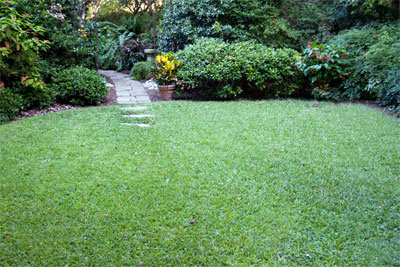From the Sperry Gardens – September, 2011

For all the decades that I’ve gardened in Texas, St. Augustine has been my preferred turfgrass. I tell people that St. Augustine is like a lot of my human friends. I find myself thinking, "You’re my friend, but my goodness, you really have a lot of issues." It’s those challenges that have scared so many people away from this traditional Texas turfgrass. This year has brought out a lot of them, but St. Augustine still does have a place in Texas landscapes. I’m just going let my fingers fly and share some of my feelings.
I prefer St. Augustine for several reasons. It’s brighter green the second half of the growing season. Bermuda tends to take on a dull, dark green appearance, while St. Augustine always looks bright and crisp.
• St. Augustine has far fewer mold spores, as measured by Texas A&M retired plant pathologist Dr. Phil Colbaugh. The one year I had a bermuda lawn, I came indoors with a sore throat every last time that I mowed it. Fifteen years later, I found out why when Phil published his findings.
• St. Augustine is more tolerant of shade than bermuda or any other warm-season turfgrass. Since summer shade is a main goal for most landscape planners, St. Augustine really comes in handy.
• St. Augustine produces no below-ground runners (rhizomes), so it’s much more easily removed from flower and groundcover beds if it invades. Bermuda is a real problem when it gets into gardens.
On the negative side of the ledger, St. Augustine does have some faults. You need to weigh them against the positives listed above. Here are a few.
• St. Augustine requires more irrigation water than bermuda and zoysias.
• St. Augustine doesn’t handle pedestrian traffic nearly as well as bermuda, so if kids are going to be wearing holes in your lawn, let the grass be bermuda. It will repopulate from its rhizomes.
• St. Augustine isn’t quite as winter-hardy as bermuda and zoysia. It can be grown from the Gulf Coast north to the Red River and two or three counties north of the I-20/I-30 corridor.
• Take All Root Rot has become a serious threat to St. Augustine turf each April and May. The grass comes out of the winter looking as if it might not green up. The leaf blades are brown, as you might imagine, but so are many of the runners. I showed you our lawn at the end of March. The photo at top shows how it looks at the end of September. The difference? The 1-inch layer of sphagnum peat moss (any brand) applied over the turf in early April (through mid-May). This is a spring disease. Many people are confusing it with other maladies, wanting to apply peat moss now. That is not a good plan. Whatever your problems might be at this time, peat moss will not help them. Save it for spring, and only as needed.
• Chinch bugs have killed big parts of thousands of St. Augustine lawns in Texas this hot, dry summer. The grass turned a dried green color, then brown in July, August or early September. Watering did not help. Chinch bugs are always a problem in the sunniest, hottest part of a St. Augustine lawn. They always show up right in the middle of this part of our lawn. Merit insecticide stops them quickly, but you have to apply it before the blades turn brown. Once the grass has died, you have to replant or wait for it to cover over again. Next time to plant: April or May, unless you’re in a really warm part of Texas along the Gulf Coast. St. Augustine can be sodded year ’round there. Note: most of the people who think they currently have active Take All Root Rot in their lawns actually are seeing chinch bug damage left over from the past couple of months. It is too late to worry about treating for chinch bugs.
• Brown patch is the third common problem for St. Augustine. As dry as it’s been, it may or may not show up this year, but it usually appears in October and into November. Round patches of yellowed blades develop. When you pull on the blades, they separate easily from the runners. You can see where the blades are rotted at that point of attachment. Water in the morning to lessen the spread of brown patch, and apply a labeled turf fungicide at first evidence to stop its spread. If it shows up this year (probably will), it will be after the weather turns cooler, especially if the cooling temperatures are accompanied by rain.

